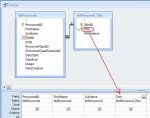wiklendt
i recommend chocolate
- Local time
- Today, 09:28
- Joined
- Mar 10, 2008
- Messages
- 1,746
I will probably try turning the lookup fields to text fields where the looked up table is a simple 1 field table without a subquery that hides the ID. I am working in Access 2007
the lookup fields should be data type of Number, and would store your corresponding primary key (PK; presumably autonumber) field from your related table, creating what is known as a foreign key (FK). you should ideally not use any field other than the autonumber field from the related table to become the foreign key (as a number field) in this table.
e.g., if you want to relate a new order with an item to be ordered, and who's ordering it...
tblOrders (hypothetical)
-----------
OrderID (Autonumber, PK)
OrderNumber (Text)
CustomerID (Number, FK)
ItemID (Number, FK)
OrderDate (Date/Time)
.
.
.
in the example table, the 'foreign' stored data would be CustomerID and ItemID. The IDs are known as "foreign" keys, because although they are not a primary key of this table, they are a primary key of a different table. the primary key of the tblOrders table is OrderID.
this assumes, then, that you have two other tables: tblCustomers and tblItems.
those tables would look something like:
tblCustomers
----------
CustomerID (Autonumber, PK)
CustomerName (Text)
.
.
.
and
tblItems
---------
ItemID (Autnumber, PK)
Code (Text)
Description (Text)
ListPrice (Currency)
.
.
.
now, when you have evil table-level lookups, the data stored in your FKs of your tblOrders table would normally STILL be the FK ID of the corresponding table, BUT the DISPLAY of the data is like a query - you just have to remove the 'combobox' in the lookup tab (i think the only other option is 'textbox' - which is what i think you meant in your post, but i feel i must clarify) of that table field and it will remove that 'display', but keep the ID.
the only time you'll need to update forms or queries is if you've imposed criteria on those tables based on the displayed data rather than the stored data. depending on the size and complexity of your database, you might be lucky to not have to do anything at all...
hope all that makes sense - it's a bit early in the morning still here!
edit: beg yours, there is also a 'listbox' option in the lookup tab for table fields... i've never used this but can only imagine it would cause horrendous headaches downstream.
Last edited:


